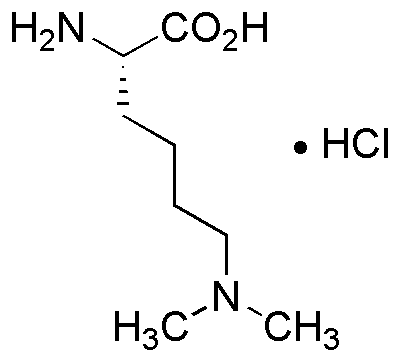Ne-Dimethyl-L-lysine hydrochloride is widely utilized in research focused on:
- Biochemical Research: This compound serves as a substrate in enzymatic studies, particularly in the investigation of lysine methylation, which is crucial for understanding gene regulation and protein function.
- Pharmaceutical Development: It is used in drug formulation processes, particularly in the development of peptide-based therapeutics, enhancing the stability and bioavailability of active pharmaceutical ingredients.
- Cell Culture Applications: Researchers incorporate this compound into cell culture media to promote cell growth and differentiation, especially in studies involving stem cells and cancer research.
- Protein Modification Studies: It aids in the study of post-translational modifications, allowing scientists to explore how methylation affects protein interactions and cellular processes.
- Diagnostic Tools: The compound is utilized in the development of diagnostic assays, particularly in detecting specific protein markers associated with diseases, providing valuable insights for early diagnosis and treatment strategies.
General Information
Properties
Safety and Regulations
Applications
Ne-Dimethyl-L-lysine hydrochloride is widely utilized in research focused on:
- Biochemical Research: This compound serves as a substrate in enzymatic studies, particularly in the investigation of lysine methylation, which is crucial for understanding gene regulation and protein function.
- Pharmaceutical Development: It is used in drug formulation processes, particularly in the development of peptide-based therapeutics, enhancing the stability and bioavailability of active pharmaceutical ingredients.
- Cell Culture Applications: Researchers incorporate this compound into cell culture media to promote cell growth and differentiation, especially in studies involving stem cells and cancer research.
- Protein Modification Studies: It aids in the study of post-translational modifications, allowing scientists to explore how methylation affects protein interactions and cellular processes.
- Diagnostic Tools: The compound is utilized in the development of diagnostic assays, particularly in detecting specific protein markers associated with diseases, providing valuable insights for early diagnosis and treatment strategies.
Documents
Safety Data Sheets (SDS)
The SDS provides comprehensive safety information on handling, storage, and disposal of the product.
Product Specification (PS)
The PS provides a comprehensive breakdown of the product’s properties, including chemical composition, physical state, purity, and storage requirements. It also details acceptable quality ranges and the product's intended applications.
Certificates of Analysis (COA)
Search for Certificates of Analysis (COA) by entering the products Lot Number. Lot and Batch Numbers can be found on a product’s label following the words ‘Lot’ or ‘Batch’.
Número de catálogo
Número de lote/lote
Certificates Of Origin (COO)
This COO confirms the country where the product was manufactured, and also details the materials and components used in it and whether it is derived from natural, synthetic, or other specific sources. This certificate may be required for customs, trade, and regulatory compliance.
Número de catálogo
Número de lote/lote
Safety Data Sheets (SDS)
The SDS provides comprehensive safety information on handling, storage, and disposal of the product.
DownloadProduct Specification (PS)
The PS provides a comprehensive breakdown of the product’s properties, including chemical composition, physical state, purity, and storage requirements. It also details acceptable quality ranges and the product's intended applications.
DownloadCertificates of Analysis (COA)
Search for Certificates of Analysis (COA) by entering the products Lot Number. Lot and Batch Numbers can be found on a product’s label following the words ‘Lot’ or ‘Batch’.
Número de catálogo
Número de lote/lote
Certificates Of Origin (COO)
This COO confirms the country where the product was manufactured, and also details the materials and components used in it and whether it is derived from natural, synthetic, or other specific sources. This certificate may be required for customs, trade, and regulatory compliance.


